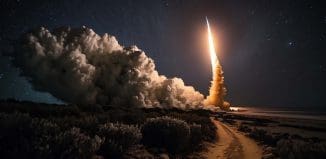Major Change Required in Battlefield Laser Tech
This post is also available in:  עברית (Hebrew)
עברית (Hebrew)
For years, the US Army has been drawn to the possibilities of directed-energy laser weapons that have a “cost per engagement substantially lower than current systems,” or about $30 per shot, by Army estimates. “The high energy laser system requires only fuel to complete its mission,” the service said. “There is no ordnance logistics burden as with conventional weapons.”
The Army has been working on a powerful new 100-kilowatt laser system to defend against enemy missiles, artillery and drone swarms but will eventually have to make it smaller and lighter to deploy. The High Energy Laser Tactical Vehicle Demonstrator (HEL TVD) is still in the “pre-prototype” stage.
The system, currently mounted on a cumbersome six-wheeler truck, is not deployable, and the design could change substantially to make it capable of being fielded on a tactical vehicle. The entire system will have to be on a single tactical vehicle.
“We’re trying to get it small enough and efficient enough to put on a platform,” Robert Snead, an engineer with the U.S. Army Space and Missile Defense Command based at Redstone Arsenal, Alabama. He added that testing of the HEL TVD “will inform the Army’s decision on how to use directed energy on the battlefield.”
The system is equipped with a Battle Management Communications, Command and Control subsystem designed to “receive target assignments with appropriate target cues from radars, then point the laser beam to engage the targets.”
The Army plans to conduct a demonstration of the HEL TVD against a range of targets in fiscal 2022. It is also working on a less powerful laser prototype in the 50-watt range called the Maneuver Short Range Air Defense (M-SHORAD), capable of being mounted on a Stryker combat vehicle, according to military.com.





























